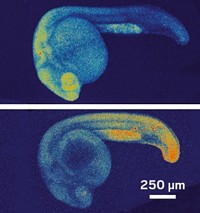Advertisement
Grab your lab coat. Let's get started
Welcome!
Welcome!
Create an account below to get 6 C&EN articles per month, receive newsletters and more - all free.
It seems this is your first time logging in online. Please enter the following information to continue.
As an ACS member you automatically get access to this site. All we need is few more details to create your reading experience.
Not you? Sign in with a different account.
Not you? Sign in with a different account.
ERROR 1
ERROR 1
ERROR 2
ERROR 2
ERROR 2
ERROR 2
ERROR 2
Password and Confirm password must match.
If you have an ACS member number, please enter it here so we can link this account to your membership. (optional)
ERROR 2
ACS values your privacy. By submitting your information, you are gaining access to C&EN and subscribing to our weekly newsletter. We use the information you provide to make your reading experience better, and we will never sell your data to third party members.
Biological Chemistry
Glowing Proteins On The Spot
Mutant bacterial enzyme labels proteins site-specifically inside live cells
by Carmen Drahl
June 7, 2010
| A version of this story appeared in
Volume 88, Issue 23
By tweaking a bacterial enzyme, Massachusetts Institute of Technology researchers have developed a new way to fluorescently label proteins at specific locations inside living cells (Proc. Natl. Acad. Sci. USA, DOI: 10.1073/pnas.0914067107). Although some chemical tags exist for this purpose, most notably green fluorescent protein, they can interfere with protein function or have other drawbacks such as toxicity or lack of selectivity. To add to the tagging tool kit, Alice Y. Ting and coworkers mutated a lipoic acid ligase enzyme from Escherichia coli. Ting’s team previously used this enzyme to label cell-surface proteins. Now, the mutant ligase binds to a blue fluorescent coumarin dye designed to enter cells. It attaches the glowing dye cargo to a 13-amino acid recognition sequence that the researchers engineer into the protein of choice. Ting and coworkers used their system to track the cytoskeletal protein actin and later used it to specifically label subsets of proteins in certain cellular locales such as the nucleus. With further improvements in speed and sensitivity, this method could illuminate protein trafficking between neuronal synapses and other compartments, the researchers write. The group has filed for a patent on the technology.





Join the conversation
Contact the reporter
Submit a Letter to the Editor for publication
Engage with us on Twitter